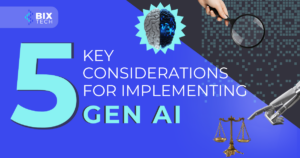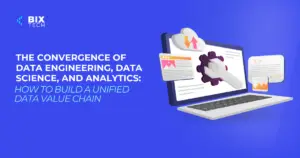Building an AI System from the Ground Up: A Practical 6-Step Guide for Businesses

Sales Development Representative and excited about connecting people
Artificial intelligence (AI), machine learning, and deep learning have become household terms over the last decade—with good reason. Thanks to leaps in processing power and the wide availability of cloud computing, organizations of all sizes can now build AI systems that perform tasks once thought impossible. From AI-generated essays to AI-created artwork winning global contests, the boundaries of what’s possible are expanding every day.
If you’re considering integrating AI into your business, you might wonder: “Is developing an AI solution really that complicated?” The answer may surprise you. While creating a state-of-the-art AI algorithm from scratch does require skill and experience, there are now hundreds of open-source and commercial tools that dramatically simplify the process. With a clear strategy, some best practices, and the right mindset, you can bring AI into your business much more easily than you might expect.
Let’s break down the essential steps to create an AI system, explore core AI types, discuss language and platform choices, and provide actionable insights along the way.
Understanding the Types of Artificial Intelligence
Before you start building, it’s vital to understand the different types of artificial intelligence and where your business needs fit in. AI is generally categorized by its capabilities and complexity:
1. Artificial Narrow Intelligence (ANI)
ANI, or “Weak AI,” is designed to perform specific tasks—think of virtual assistants like Siri or Alexa, or recommendation systems on streaming platforms. These systems excel in narrow domains but can’t transfer knowledge between different tasks.
Practical Example:
An e-commerce company uses ANI to power its product recommendation engine, increasing sales through personalized suggestions.
Actionable Takeaway:
If your goal is to automate a defined process or enhance a specific business function, start with ANI-powered solutions. They’re mature, widely available, and perfect for tasks like customer support, fraud detection, and predictive analytics.
2. Artificial General Intelligence (AGI)
AGI—often called “Strong AI”—remains mostly theoretical. It refers to AI that can perform any intellectual task a human being can, adapting to new situations and learning across domains.
Case Study:
While true AGI is still in the research phase, companies experimenting with advanced AI assistants aim to create systems that can understand and respond as flexibly as a human. For instance, some startups are piloting AGI-like chatbots that can handle cross-departmental queries with minimal retraining.
Actionable Takeaway:
Keep an eye on AGI developments for future-proofing your AI strategy, but for now, focus your resources on mature ANI technologies that solve real business problems today.
3. Artificial Superintelligence (ASI)
ASI is a hypothetical form of AI that surpasses human intelligence in all aspects. It would be capable of self-improvement, strategic thinking, and even creativity on a level beyond the brightest human minds.
Consideration:
The concept of ASI raises important ethical, social, and business questions. As the technology evolves, organizations will need to address topics such as responsible AI adoption, alignment with human values, and industry disruption.
Actionable Takeaway:
While ASI is not yet a practical concern, businesses should start developing frameworks for ethical AI use and consider how future advancements might impact their industry.
Choosing the Best Programming Language for AI Development
Selecting the right programming language is a foundational decision in your AI journey. While almost any general-purpose language can be adapted for AI, some stand out for their efficiency, ecosystem, and ease of use.
1. Python: The AI Powerhouse
Python dominates the AI landscape thanks to its simplicity and rich library ecosystem. Libraries such as PyTorch and TensorFlow make it easy to build and train sophisticated machine learning models.
- PyTorch: Excellent for research and prototyping deep learning models.
- TensorFlow: Widely used for scalable machine learning applications and production environments.
Actionable Takeaway:
If you’re just starting out or want maximum flexibility, Python is your best bet. Its broad adoption means you’ll find plenty of tutorials, community support, and ready-made tools for every stage of AI development. For more on Python’s strengths in the AI space, see Why Python is the Ideal Language for AI.
2. Julia: Speed for the Cutting Edge
Julia is gaining traction among data scientists who need high-performance computing. It’s faster than Python for many tasks and is ideal for large-scale numerical simulations.
Actionable Takeaway:
If your project requires intensive computation—such as real-time data analysis or scientific simulations—Julia is worth exploring.
3. R: The Analyst’s Choice
R is the go-to language for statisticians and researchers, excelling at data analysis and visualization.
Practical Example:
A healthcare company uses R to analyze large sets of patient data, discovering trends that improve clinical decision-making.
Actionable Takeaway:
Choose R if your AI system centers on statistical modeling, data visualization, or academic research.
4. Other Languages (Scala, Java, C++)
Languages like Scala, Java, and C++ remain relevant for high-performance applications, especially where speed and scalability are critical.
- Key Use Case:
Banks and fintech firms often use Java-based AI systems for real-time fraud detection.
Actionable Takeaway:
Consider these languages if your organization already relies on them for core systems, or if you need to integrate AI with legacy infrastructure.
Step-by-Step: How to Build an AI System for Your Business
Let’s walk through a streamlined, six-step approach to building an AI solution tailored to your organization’s needs:
1. Define Your Business Problem
Start with a clear objective.
Are you aiming to improve customer retention, automate manual tasks, or gain insights from unstructured data? Pinpointing your business challenge ensures your AI efforts remain focused and measurable.
Case Study:
A logistics company wanted to optimize delivery routes. By framing the problem clearly, they implemented an AI-powered route optimization tool, reducing fuel costs by 18% in the first quarter.
Actionable Takeaway:
Begin every AI project with a well-defined business question. This anchors the entire development process and maximizes ROI.
2. Collect and Prepare Data
Quality data is the backbone of AI.
Gather relevant, high-quality datasets and invest time in data cleaning to remove errors and inconsistencies.
Practical Example:
A retail chain used three years’ worth of sales and inventory data to train a demand forecasting model—after extensive data cleaning and normalization for reliability.
Actionable Takeaway:
Don’t underestimate data preparation. Allocate ample resources to data collection, cleaning, and preprocessing for robust AI outcomes. For a deeper dive, check out Data Science: The Business Revolution.
3. Choose the Right AI Platform
Selecting a development platform sets the stage for your project’s success. Consider:
- Use Case Fit:
- Google Cloud AI for natural language and translation.
- Microsoft Azure ML for advanced model building and deployment.
- AWS AI Services for scalability and integration with cloud infrastructure.
- Security and Compliance:
Ensure your platform meets your industry’s data security standards.
- No-Code Options:
Platforms like IBM Watson AutoML allow non-technical users to build models without writing code.
Actionable Takeaway:
Match your platform to your organizational needs, technical expertise, and compliance requirements. Evaluate trial versions before committing to a long-term solution.
4. Select the Right Model and Algorithms
With your data and platform in place, choose a machine learning model that fits your objective:
- Classification (e.g., fraud detection)
- Regression (e.g., sales forecasting)
- Clustering (e.g., customer segmentation)
Practical Example:
A telecom company used clustering algorithms to identify customer segments, enabling targeted marketing campaigns and reducing churn.
Actionable Takeaway:
Consult with data scientists or use automated ML tools to experiment with different models and select the most effective one for your data.
5. Train, Test, and Tune
This is where your AI comes to life. Split your data into training and test sets, train your model, and evaluate its performance.
- Iterate: Continuously refine your model using feedback from test results.
- Monitor: Use dashboards to track accuracy, false positives, and other key metrics.
Actionable Takeaway:
Adopt an iterative approach—train, test, and tune repeatedly until your model delivers consistent and reliable results.
6. Deploy and Monitor Your AI Solution
Once your model performs satisfactorily, deploy it into your business environment. Set up ongoing monitoring for accuracy, performance, and security.
Case Study:
An insurance provider launched an AI claims processing system, which automatically flagged suspicious claims for human review. Continuous monitoring allowed them to update the algorithm based on evolving fraud patterns.
Actionable Takeaway:
Deployment is not the finish line—establish a process for ongoing monitoring and improvement to keep your AI system effective and compliant.
Final Thoughts: Accelerating AI Adoption in Your Organization
AI is transforming industries across the globe. Today, the tools and platforms are more accessible than ever, allowing organizations to build custom AI systems that deliver tangible business value. Whether you’re automating a single workflow or laying the groundwork for future AGI adoption, success starts with a clear strategy and practical steps.
If you’re ready to take the next step, consider exploring our guide on Exploring AI PoCs in Business to discover how proof-of-concept projects can accelerate your AI journey.
Key Takeaways
- Start with a clear business problem and focus on AI types relevant to your needs.
- Choose programming languages and platforms based on your project goals and existing infrastructure.
- Prioritize data quality—clean, accurate data underpins all successful AI projects.
- Use iterative model training, testing, and tuning for optimal results.
- Deploy with robust monitoring and plan for continuous improvement.
By following these steps, your business can harness the power of artificial intelligence to drive innovation, efficiency, and growth.









